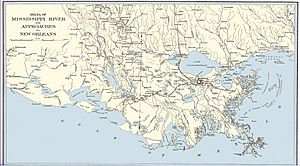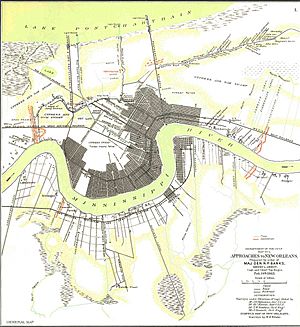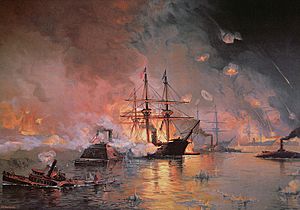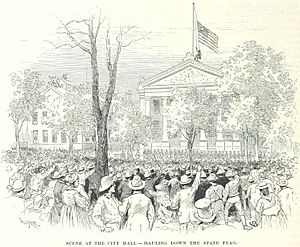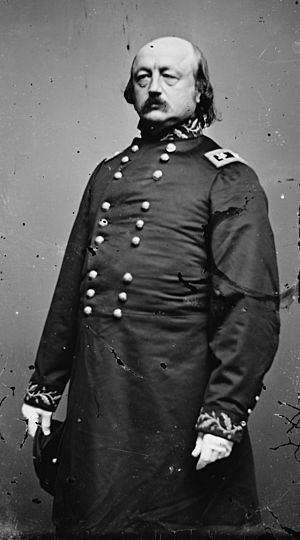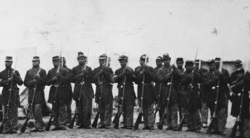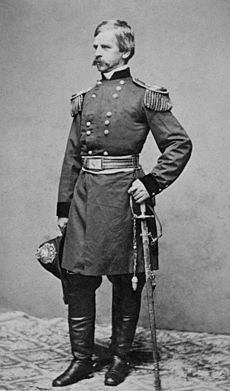Capture of New Orleans facts for kids
Quick facts for kids Capture of New Orleans |
|||||||
|---|---|---|---|---|---|---|---|
| Part of the American Civil War | |||||||
 Panoramic view of New Orleans; Federal fleet at anchor in the river (c. 1862) |
|||||||
|
|||||||
| Belligerents | |||||||
| Commanders and leaders | |||||||
| David Farragut Benjamin Butler |
Mansfield Lovell | ||||||
| Units involved | |||||||
| Department of the Gulf West Gulf Blockading Squadron |
Department No. 1 | ||||||
| Casualties and losses | |||||||
| none | none | ||||||
The capture of New Orleans happened from April 25 to May 1, 1862, during the American Civil War. This event was a major turning point in the war. It led to the Union gaining control of the Mississippi River. After fighting past Forts Jackson and St. Philip, the Union forces took the city without further fighting. New Orleans was saved from the destruction that many other Southern cities faced.
Many people in the city did not like the strict rules set by the U.S. Army's military governor. This caused long-lasting bad feelings. Taking control of New Orleans, the largest city in the Confederacy, was a very important moment. It had a big impact on the war and even on other countries.
Contents
Why Was New Orleans Important?
The history of New Orleans is different from other cities in the Confederate States of America. It was first founded by the French. Then, it was controlled by Spain for a while. This meant many people in New Orleans were Catholic. The city had a very diverse and open culture. In 1810, only a small part of the population was Anglo-American. Most people spoke French. They included Creoles and people who had moved from Haiti.
New Orleans was a very important port city. It was located near the mouth of the Mississippi River, close to the Gulf Coast. The Mississippi River connected to many other rivers. This made New Orleans a huge center for trade and transportation. This was especially true before railroads became common. Two inventions made New Orleans even more important. These were the cotton gin in 1793 and the steamboat in the early 1800s.
Before steamboats, people would bring goods downriver on simple boats. They would then break up their boats for wood in New Orleans. Then, they would travel back home by land. Steamboats changed this because they could travel upstream against the river's strong current. This made two-way trade possible between New Orleans and cities further north. After the Napoleonic Wars ended in 1815, global trade grew a lot. Cotton became a very valuable product. It was a huge part of the goods moved through New Orleans.
How Did New Orleans Grow?
A key event in New Orleans' early history was the 1815 Battle of New Orleans. General Andrew Jackson led American forces to victory in this battle during the War of 1812. This win helped his political career. Jackson later helped start the Democratic Party. He began a new political movement called Jacksonian democracy.
This new political direction greatly shaped New Orleans and the American Southwest. One result was the building of Fort Jackson, Louisiana. This fort was named after Jackson. It was meant to protect the Mississippi River from attacks. It worked with Fort St. Philip to guard the river's entrance.
Leaders who followed Jackson supported the idea of Manifest Destiny. This idea meant expanding the United States across the continent. They also supported international trade and the growth of slavery. This powerful movement caused tension between the northern and southern parts of the U.S. By 1860, New Orleans was very powerful. It had strong economic, military, and political influence. The Mexican–American War and the Texas annexation made New Orleans even more important. The California Gold Rush also added to the city's wealth.
By 1860, New Orleans was one of the world's biggest ports. It had 33 different steamship lines. Trade worth $500 million passed through the city. It was the largest city in the South. Its population was about 168,675 people. This was more than the next four largest Southern cities combined.
The War Begins and the Battle for the City
When Abraham Lincoln was elected president in 1860, Louisiana's governor, Thomas Overton Moore, took action. He stopped an idea to make New Orleans a "free city" or neutral area. Moore, a strong Democrat, led a movement to vote Louisiana out of the Union. This decision was made by a small group, representing only 5% of Louisiana's citizens. Moore also ordered the Louisiana militia to take over Federal military sites. These included the arsenal at Baton Rouge and the forts guarding the approach to New Orleans. These actions happened before the state officially left the Union. Louisiana voted to leave the Union 113 to 17. This led to the story of New Orleans in the Civil War.
The Union's plan was called the "Anaconda Plan" by Winfield Scott. It aimed to split the Confederacy by taking control of the Mississippi River. The first step was to create a Union blockade. This blockade stopped ships from entering or leaving Confederate ports. After the blockade, Confederate ships tried to fight back. The Union then decided to enter the Mississippi River and capture New Orleans. This would close the river to Confederate ships. In January 1862, Flag Officer David Farragut began this mission. His fleet, the West Gulf Blockading Squadron, moved up the river. The only obstacles were two forts, Fort Jackson and Fort St. Philip. These forts were about 70 miles downriver from New Orleans.
From April 18 to 28, Farragut's ships attacked these forts. They fought their way past them in the Battle of Forts Jackson and St. Philip. By April 24, thirteen of his ships were upriver. Historians noted that the Confederate fleet did not perform well. Many ships were destroyed or had untrained officers. The Union gunboats caused heavy damage. The Confederate defenses were not strong enough. They lacked money, organization, and skilled workers.
Major General Mansfield Lovell, the Confederate commander, had few choices left. Once the Union Navy broke through the forts, he had to evacuate. The inner defenses of New Orleans were only for ground troops. Few cannons were aimed at the river. Most of the Confederate forces were at the forts. After the forts fell, only about three thousand militiamen were left to defend the city. They had shotguns and limited supplies. New Orleans was not easy to defend against a fleet. The Union ships were high above the city due to the levees. They could fire down into the streets. There was also a risk that Union forces could break a levee. This would flood and destroy most of the city.
Lovell loaded his troops and supplies onto a train. He sent them to Camp Moore, 78 miles north. All cannons and ammunition went to Vicksburg. Lovell sent a final message to the Confederate War Department. He said, "The enemy has passed the forts. It is too late to send any guns here; they had better go to Vicksburg." Confederate military supplies, ships, and warehouses were then burned. Anything useful to the Union, including thousands of cotton bales, was thrown into the river.
Even though the city was completely open, citizens and leaders remained defiant. On April 25, Admiral Farragut sent Captain Bailey to accept the city's surrender. But angry crowds in the city resisted the Union officers. General Lovell and Mayor Monroe refused to surrender. One citizen, William B. Mumford, pulled down a Union flag. This flag had been raised over the former U.S. mint by Union marines. The crowd then destroyed the flag. Farragut did not destroy the city in response. Instead, he moved upriver to deal with forts north of the city. On April 29, Farragut and 250 marines removed the Louisiana State flag from City Hall. By May 2, the U.S. Secretary of State declared New Orleans "recovered."
Union Occupation of New Orleans
On May 1, 1862, Major General Benjamin Butler entered New Orleans with 5,000 soldiers. He met no resistance. Butler was a former lawyer and politician. President Lincoln appointed him as one of the first Major Generals of Volunteers. He was known for preparing his Massachusetts militia for war. He quickly helped Washington, D.C., and restored order in Baltimore, Maryland. As a reward, he commanded Fortress Monroe in Virginia. There, he became known for treating runaway enslaved people as "contraband of war." This meant they were taken by the Union army and not returned to their owners. This policy later became official. Because of his political skills, Butler was chosen to lead the army to New Orleans.
Challenges of Controlling the City
The U.S. War Department expected Butler to hold eastern Louisiana. This included Baton Rouge and New Orleans. He also had to keep communication open upriver to Vicksburg. New Orleans itself was hard to defend. It was surrounded by levees and was lower than the river. This made it very open to flooding, attacks, and rebellion. The city was also unhealthy and prone to diseases. Defending it from Confederate attacks needed many soldiers and strong forts. Louisiana, as a conquered area, could use up many Union resources. It could become a problem if people resisted strongly. Many thought the Confederacy would try to take New Orleans back. Losing this large city, with its industries and shipping, would be a huge blow to the Confederacy.
Butler's Rule in New Orleans
Butler was a very controversial figure during the Civil War. He became famous in New Orleans for his harsh orders and claims of corruption. Confederate officials made it seem like New Orleans was held by brutal military force. Butler was a "political general." He got his position through political connections. This background helped him stay in New Orleans until public anger forced his removal in 1862. Butler faced a tough job. He had to control the Confederacy's largest city with a small force. He had only 15,000 troops in total. He received no more soldiers between May and December 1862. Butler said, "We were 2,500 men in a city... of 150,000 inhabitants, all hostile." His ways of keeping order were very strict. They were even seen as extreme in the North and Europe. One example was his General Order No. 28.
Butler's General Order No. 28
The people of New Orleans, especially many women, did not like the Union occupation. Butler's soldiers faced many insults from women. These included avoiding soldiers, spitting on them, and throwing dirty water on them. The Union troops were offended. After two weeks, Butler had enough. He issued General Order No. 28. This order told Union soldiers to treat any woman who insulted a soldier "as a woman of the town plying her avocation." This meant treating them as if they were engaging in illegal activities.
HEADQUARTERS. DEPARTMENT OF THE GULF
- New Orleans, May 15, 1862.
- Since officers and soldiers of the United States have been insulted repeatedly by women (who call themselves ladies) of New Orleans, despite our careful non-interference and politeness, it is ordered that from now on, if any female insults or shows disrespect to any officer or soldier of the United States by word, gesture, or movement, she will be considered and treated as a woman engaging in illegal activities.
- By command of Major-General Butler:
- GEO. C. STRONG,
- Assistant Adjutant-General and Chief of Staff.
The reaction to Butler's General Order No. 28 was immediate and very strong. Women in the South were deeply offended. Butler was heavily criticized both in the U.S. and in other countries. This was a problem because the Union wanted to avoid European countries getting involved in the war. Butler became known as "The Beast." The British House of Lords called it a "most terrible proclamation." They saw it as a "most gross, brutal, and unmanly insult to every woman in New Orleans." Butler tried to defend his order. He claimed it was effective. He said the best way to deal with defiant women was to ignore them. Butler's controversial order caused a big public relations problem for the Union. He was removed from command in New Orleans in December 1862, just 8 months after taking over.
Building Support in New Orleans
Butler's greatest strength in New Orleans was his political background. He was a populist and a reformer. He was good at connecting with ordinary people's issues. He used these skills to control New Orleans. He rewarded Union supporters and isolated those who supported the Confederacy.
Butler started his rule by punishing anyone who cheered for Confederate leaders. They would get three months of hard labor. He also ordered that captured Confederate food supplies be given to the poor. The Union Blockade had hurt the city's economy. Many people were jobless. The value of goods passing through New Orleans dropped sharply.
Butler also formed three regiments of infantry. These were called the Louisiana Native Guards. They were made up of free Black militia units. These units were special because they had Black officers. They helped increase Butler's forces. They also showed the city's former ruling classes that their former enslaved people were now armed. Butler also worked to restart trade in the city. He exported cotton and brought back international trade. He hired many local people to help the Union military. They also cleaned up the city. He expanded the sewer system and used pumps to clean it. This helped prevent a yellow fever outbreak that summer. This likely saved thousands of lives. He heavily taxed the wealthy to fund social programs for the poor. These actions helped him gain wide support. They also provided him with an intelligence network. This helped him maintain law and order.
Impact on Enslaved People
Butler had already weakened slavery in the Confederacy. He started his "contraband of war" policy at Fort Monroe. This policy meant that enslaved people who fled from Confederate states were kept by the Union army. This was because the Confederacy used enslaved labor for military work. Enslaved people in Confederate areas quickly learned that Union forces would not return them. They could find safety and work with the Union armies. This made it very hard and costly for the Confederacy to use enslaved labor near Union forces. This policy hurt the Confederacy's plan to use enslaved labor to make up for fewer soldiers.
The flight of enslaved people also forced the Confederacy to use resources to protect plantations. Planters in Louisiana even asked Union authorities for help. They feared rebellions by enslaved people. The plantations of Jefferson Davis, the Confederate President, were also affected. After Davis's brother fled, the remaining enslaved people rebelled. They took control of the property. They also helped Union forces find valuables. They fought against any Confederate attempts to retake the area. This rebellion within a rebellion weakened Confederate power in Louisiana. It was very helpful to Butler's occupation.
Confederate Counterattack Fails
The expected Confederate counterattack happened on August 5. Major General John C. Breckinridge led a naval and army attack on Baton Rouge. This led to the Battle of Baton Rouge. After a tough fight, Confederate forces were driven out of the city. Both sides then withdrew. The important thing was that this battle did not lead to a popular uprising in Louisiana. As a result, Confederate forces could not launch a long campaign to retake New Orleans. This showed how well Butler had built support among the people. One historian noted that the poorer people, both Black and white, would have starved if Butler had not fed and employed them. His sanitation policies also saved many lives from disease.
Butler's Reputation and Results
Butler's harsh style and actions caused him problems. Many of his actions offended people. For example, he seized money from the Dutch consul's office. He also imprisoned a French businessman. His most famous act was General Order No. 28 on May 15. This order came after many insults from women in New Orleans. It said that if any woman insulted a Union soldier, she would be treated as a "woman of the town." This order caused protests in the North, South, and especially in Britain and France. Many believed it led to his removal from command on December 17, 1862. He was also called "Beast Butler" and "Spoons." This was because people claimed he stole silverware from Southern homes. He became so disliked that merchants sold chamber pots with his face on the bottom.
On June 7, Butler ordered the execution of William B. Mumford. Mumford had torn down a U.S. flag in New Orleans. For this execution, Confederate President Jefferson Davis declared Butler a criminal in December 1862. Davis said Butler should be executed if captured. Despite his bad reputation, Butler's rule did benefit the city. New Orleans remained orderly and healthy. Admiral Farragut perhaps best summarized Butler's time in New Orleans. He said, "They may say what they please about General Butler, but he was the right man in the right place in New Orleans."
What Happened Next?
On December 14, 1862, Major General Nathaniel Banks arrived to take command. Butler was not told about the change until Banks arrived. It is often thought that Butler's controversial rule caused his replacement. However, political reasons in other states were more important. Democratic wins in Illinois and Ohio in November worried the Lincoln administration. The governor of Indiana even wrote that states along the Ohio River had more in common with the South. He warned they might leave the Union if the Mississippi River was not reopened for trade.
These concerns supported the idea of Secretary of State William H. Seward. He was one of Butler's political rivals. Seward believed that an invasion of Texas would be welcomed by pro-Union German American cotton farmers there. Banks, a political general from New England, supported this idea. He wanted to send cotton to mills in the Northeast. Banks then led the siege of Port Hudson. After that success, he began the Red River campaign. This campaign aimed to get Texan cotton. However, the Red River expedition was a costly failure. It caused more destruction and looting than Butler's occupation.


